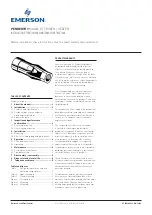
67
Haas effect
A psychoacoustic effect in which the time
of arrival of a sound to the left and right ears
affects our perception of direction. If a signal
is presented to both ears at the same time at
the same volume, it appears to be directly in
front of us. But if the signal to one ear, still at
the same volume, is delayed slightly (0 to 5
msec), the sound appears to be coming from
the earlier (non-delayed) side.
headroom
The difference between nominal operating
level and peak clipping in an audio system. For
example, a mixer operating with a nominal
line level of +4dBu and a maximum output
level of +22dBu has 18dB of headroom. Plenty
of room for surprise peaks.
Hertz
The unit of measure for frequency of oscilla-
tion, equal to 1 cycle per second. Abbreviated
Hz. KHz is pronounced “kay-Hertz” and is an
abbreviation for kilohertz, or 1000 Hertz.
house
In Sound Reinforcement parlance, “house”
refers to the systems (and even persons) re-
sponsible for the primary sound reinforcement
in a given hall, building, arena or “house.”
Hence we have the house mixer or house engi-
neer, the house mix, the house mix amps, the
main house speakers and so on.
Hz
See
Hertz.
impedance
The A.C. resistance/capacitance/inductance
in an electrical circuit, measured in ohms. In
audio circuits (and other AC circuits) the im-
pedance in ohms can often be much different
from the circuit resistance as measured by a
DC ohmmeter.
Maintaining proper circuit impedance rela-
tionships is important to avoid distortion and
minimize added noise. Mackie input and out-
put impedances are set to work well with the
vast majority of audio equipment.
input module
A holdover from the days when the only
way that real consoles were built was in
modular fashion, one channel per module.
See
channel strip
.
knee
A knee is a sharp bend in an EQ response
curve not unlike the sharp bend in your leg.
Also used in describing dynamics processors.
level
Another word for signal voltage, power,
strength or volume. Audio signals are some-
times classified according to their level.
Commonly used levels are: microphone level
(–40dBu or lower), instrument level (–20 to
–10dBu), and line level (–10 to +30dBu).
line level
A signal whose level falls between –10dBu
and +30dBu.
main house speakers
The main loudspeakers for a sound rein-
forcement system. These are usually the
largest and loudest loudspeakers, and are
usually positioned so that their sound seems
to come from the area of the main stage.
mains
See
main house speakers.
master
A control affecting the final output of a
mixer. A mixer may have several master
controls, which may be slide faders or rotary
controls.
mic amp
See
mic preamp.
mic level
The typical level of a signal from a micro-
phone. A mic level signal (usually but not
always coming from a microphone) is gener-
ally below –30dBu. With a very quiet source (a
pin dropping?) the signal can be –70dBu or
lower. It is also possible for some microphones
to deliver more signal than this, in which case
it may be referred to as a “hot” mic level. Alter-
natively, you can just say, “Boy, is that loud!”
mic pre
See
mic preamp.
mic preamp
Short for microphone preamplifier. An am-
plifier that functions to bring the very low
signal level of a microphone (approximately
–50dBu) up to line level (approximately
0dBu). Mic preamps often have their own vol-
ume control, called a trim control, to properly
set the gain for a particular source. Setting the
mic preamp gain correctly with the trim con-
trol is an essential step in establishing good
noise and headroom for your mix.
















































